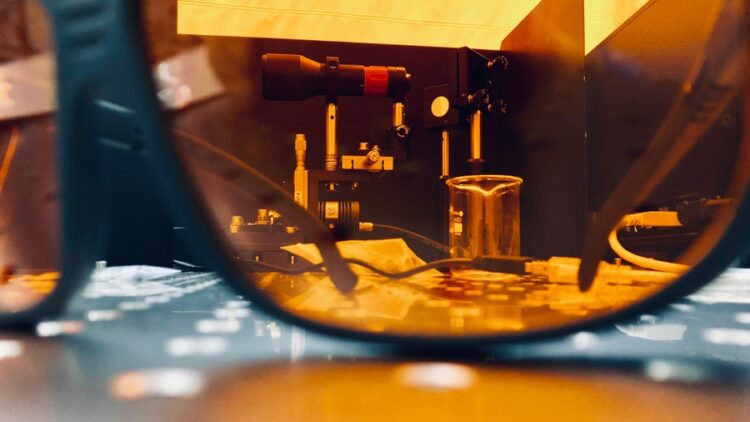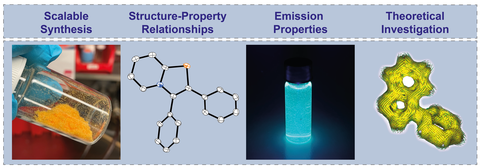Innovating Optoelectronic Components with Phosphorus

© Sebastian Reineke
Phosphorus chemist Prof. Jan J. Weigand from the Dresden University of Technology, in collaboration with an interdisciplinary team, has developed a groundbreaking method to introduce phosphorus and nitrogen atoms into polycyclic molecules. This method holds the potential to pave the way for the development of new materials with specific optoelectronic properties, ideal for applications in organic semiconductor technologies such as OLEDs and sensors. The results of this promising endeavour were published this week in the prestigious journal CHEM.
Polyaromatic hydrocarbons, abbreviated as PAHs, play a central role in numerous (opto-) electronic applications, including chemical sensors, organic light-emitting diodes (OLEDs), organic field-effect transistors (OFETs), and organic solar cells. Researchers are continually exploring the substitution of various elements beyond traditional carbon to optimize device performance and versatility. While substitution with boron (B), nitrogen (N), oxygen (O), and sulfur (S) has already undergone extensive research, the integration of phosphorus (P) in combination with nitrogen (N) remains a significant challenge.
Prof. Jan J. Weigand and his research group at TUD Dresden University of Technology have recently achieved a significant breakthrough: “In our current research, we have developed an innovative method to selectively introduce phosphorus and nitrogen atoms into polyaromatic systems. This method allowed the synthesis of a wide range of P/N-substituted compounds, whose physicochemical properties were thoroughly investigated in collaboration with physicists from TUD. Through the combination of material simulations and spectroscopic measurements, we were able to gain fundamental insights into the structure-property relationships of the obtained compounds.”
The new method provides access to the well-known class of azaphospholes, which were previously only accessible in a very cumbersome manner and mostly in very low yields. Therefore, they were not considered for (opto-)electronic applications until now. “By deliberately combining phosphorus and nitrogen, we hope to be able to control the electronic and optical properties of these compounds in a way that was not possible before. This opens up exciting prospects for future applications in optoelectronics and beyond,” adds Sebastian Reineke, head of the Light-Emitting and eXcitonic Organic Semiconductors Group (LEXOS) at TUD.
Wissenschaftliche Ansprechpartner:
Prof. Jan J. Weigand
Chair of Inorganic Molecular Chemistry
TUD Dresden University of Technology
Tel.: +49 351 463-42800
jan.weigand@tu-dresden.de
Dr. Kai Schwedtmann
Weigand Research Group
TUD Dresden University of Technology
Tel.: +49 351 463-42803
kai.schwedtmann@tu-dresden.de
Prof. Sebastian Reineke
Chair of Organic Semiconductors
TUD Dresden University of Technology
Tel.: +49 351 463-38686
sebastian.reineke@tu-dresden.de
Originalpublikation:
Jannis Fidelius, Kai Schwedtmann, Sebastian Schellhammer, […], Antonio Frontera, Sebastian Reineke, Jan J. Weigand. Convenient Access to π-Conjugated 1,3-Azaphospholes from Alkynes via [3+2]-Cycloaddition and Reductive Aromatization, CHEM. DOI: 10.1016/j.chempr.2023.10.016
Media Contact
All latest news from the category: Interdisciplinary Research
News and developments from the field of interdisciplinary research.
Among other topics, you can find stimulating reports and articles related to microsystems, emotions research, futures research and stratospheric research.
Newest articles

Innovative 3D printed scaffolds offer new hope for bone healing
Researchers at the Institute for Bioengineering of Catalonia have developed novel 3D printed PLA-CaP scaffolds that promote blood vessel formation, ensuring better healing and regeneration of bone tissue. Bone is…

The surprising role of gut infection in Alzheimer’s disease
ASU- and Banner Alzheimer’s Institute-led study implicates link between a common virus and the disease, which travels from the gut to the brain and may be a target for antiviral…

Molecular gardening: New enzymes discovered for protein modification pruning
How deubiquitinases USP53 and USP54 cleave long polyubiquitin chains and how the former is linked to liver disease in children. Deubiquitinases (DUBs) are enzymes used by cells to trim protein…




